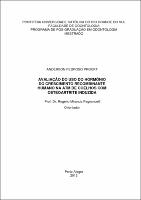| Compartilhe o registro |


|
Use este identificador para citar ou linkar para este item:
https://tede2.pucrs.br/tede2/handle/tede/1184Registro completo de metadados
| Campo DC | Valor | Idioma |
|---|---|---|
| dc.creator | Prockt, Anderson Pedroso | - |
| dc.creator.Lattes | http://buscatextual.cnpq.br/buscatextual/visualizacv.do?id=K4584913P7 | por |
| dc.contributor.advisor1 | Pagnoncelli, Rogerio Miranda | - |
| dc.contributor.advisor1Lattes | http://buscatextual.cnpq.br/buscatextual/visualizacv.do?id=K4797344J4 | por |
| dc.date.accessioned | 2015-04-14T13:30:16Z | - |
| dc.date.available | 2012-10-29 | - |
| dc.date.issued | 2012-08-31 | - |
| dc.identifier.citation | PROCKT, Anderson Pedroso. Avaliação do uso do hormônio do crescimento recombinante humano na ATM de coelhos com osteoartrite induzida. 2012. 98 f. Dissertação (Mestrado em Odontologia) - Pontifícia Universidade Católica do Rio Grande do Sul, Porto Alegre, 2012. | por |
| dc.identifier.uri | http://tede2.pucrs.br/tede2/handle/tede/1184 | - |
| dc.description.resumo | A osteoartrite é uma doença lentamente progressiva e degenerativa que atinge várias articulações do corpo humano, incluindo a ATM. A engenharia tecidual tem avançado no sentido de reduzir os defeitos osteocondrais e regenerar essa articulação. Foram utilizados no estudo 19 coelhos, dos quais 18 tiveram os discos articulares da ATM removidos, com o intuito de induzir osteoartrite. Os animais foram divididos em 3 grupos com 6 cobaias: grupo A, onde 5 coelhos realizaram 1 infiltração na articulação direita com rhGH (0,5UI/kg) e na esquerda com NaCl (0,9%) em 14 dias; grupo B, onde 5 coelhos realizaram 1 infiltração na articulação direita com rhGH (0,5UI/kg) e na esquerda com NaCl (0,9%) em 14 e 21 dias; grupo C, onde 5 coelhos realizaram 1 infiltração na articulação direita com rhGH (0,5UI/kg) e na esquerda com NaCl (0,9%) em 14, 21 e 28 dias. O sexto coelho de cada grupo não recebeu infiltrações e serviu como controle. O 19º coelho não foi operado e serviu como controle de ATM normal. Os animais foram avaliados por tomografia computadorizada cone beam e histologicamente. Os resultados demonstraram que, tomograficamente, as articulações tratadas com 3 infiltrações de NaCl 0,9% e o grupo controle obtiveram maiores índices de osteoartrite (p<0,05). Na análise histológica, as articulações tratadas com rhGH apresentaram maior celularidade e espessura tecidual no grupo A, no grupo B, as articulações infiltradas com rhGH e NaCl (0,9%) apresentaram maior celularidade e espessura que no grupo controle. Quanto ao grau de severidade da osteoartrite, não houve diferença estatística. | por |
| dc.description.abstract | Osteoarthritis is a slowly progressive degenerative disease affecting several joints of the human body, including the TMJ. Tissue engineering has advanced to reduce osteochondral defects and to regenerate the TMJ. Nineteen rabbits were used in the present study. Eighteen of them had the articular discs of the TMJ removed in order to induce osteoarthritis. The animals were divided into three groups of six rabbits: group A - five rabbits treated with injections of rhGH (0.5 IU/kg) in the right joint and NaCl (0.9%) in the left joint in 14 days; group B - five rabbits received injections of rhGH (0.5 IU/kg) in the right joint and NaCl (0.9%) in the left joint in 14 and 21 days; and group C - five rabbits underwent injections of rhGH (0.5 IU/kg) in the right joint and NaCl (0.9%) in the left joint in 14, 21, and 28 days. The sixth rabbit of each group was the control and did not receive injections. The 19th rabbit was used as a normal TMJ control and did not undergo surgery. The animals were evaluated using cone beam computed tomography and histological examination. CT showed that the joints treated with three injections of 0.9% NaCl and the control group had higher rates of osteoarthritis (p < 0.05). Histological analysis revealed that the joints treated with rhGH had higher tissue cellularity and thickness in group A, whereas the joints treated with rhGH and NaCl (0.9%) had high tissue cellularity and thickness in group B than in the control group. There was no statistical difference in terms of degree of severity of osteoarthritis. | eng |
| dc.description.provenance | Made available in DSpace on 2015-04-14T13:30:16Z (GMT). No. of bitstreams: 1 443201.pdf: 4831267 bytes, checksum: 8dd21e93476eb996bc1ebeb289330d2b (MD5) Previous issue date: 2012-08-31 | eng |
| dc.format | application/pdf | por |
| dc.thumbnail.url | http://tede2.pucrs.br:80/tede2/retrieve/8085/443201.pdf.jpg | * |
| dc.language | por | por |
| dc.publisher | Pontifícia Universidade Católica do Rio Grande do Sul | por |
| dc.publisher.department | Faculdade de Odontologia | por |
| dc.publisher.country | BR | por |
| dc.publisher.initials | PUCRS | por |
| dc.publisher.program | Programa de Pós-Graduação em Odontologia | por |
| dc.rights | Acesso Aberto | por |
| dc.subject | ODONTOLOGIA | por |
| dc.subject | ARTICULAÇÃO TEMPOROMANDIBULAR | por |
| dc.subject | OSTEOARTRITE | por |
| dc.subject | HORMÔNIO DO CRESCIMENTO | por |
| dc.subject.cnpq | CNPQ::CIENCIAS DA SAUDE::ODONTOLOGIA | por |
| dc.title | Avaliação do uso do hormônio do crescimento recombinante humano na ATM de coelhos com osteoartrite induzida | por |
| dc.type | Dissertação | por |
| Aparece nas coleções: | Programa de Pós-Graduação em Odontologia | |
Arquivos associados a este item:
| Arquivo | Descrição | Tamanho | Formato | |
|---|---|---|---|---|
| 443201.pdf | Texto Completo | 4,72 MB | Adobe PDF |  Baixar/Abrir Pré-Visualizar |
Os itens no repositório estão protegidos por copyright, com todos os direitos reservados, salvo quando é indicado o contrário.




